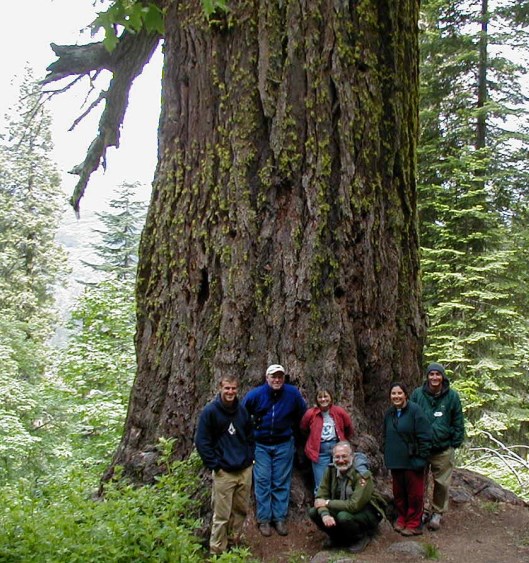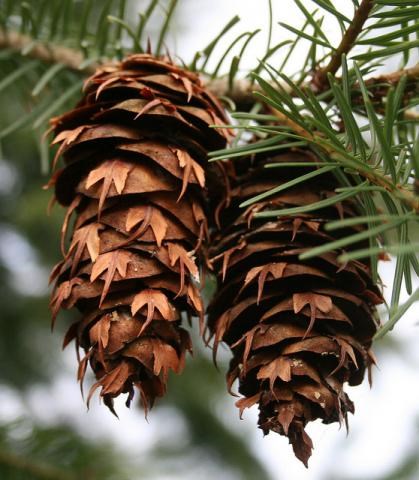Last updated: May 15, 2025
Article
Coast Douglas-fir

NPS
General Description
Douglas-fir trees, sometimes called red firs, Oregon pines, and Douglas spruce, are neither true fir trees nor pines nor spruces! The genus name Pseudotsuga means “false hemlock,” referencing another kind of tree they resemble. The common name (honoring Scottish botanist David Douglas) is hyphenated to indicate it is not a true fir. Two varieties of Douglas-fir exist—coast (Pacific Northwest and California) and Rocky Mountain (interior west). Coast Douglas-fir (Pseudotsuga menziesii menziesii) commonly reach 250 feet tall and 5 to 7 feet wide, though maximum heights can reach well over 300 feet and diameters can reach 15 to 18 feet. Douglas-fir ranks as the second tallest tree species in the world behind coastal redwood. Its spreading branches are covered in 1-inch needles slightly pointed at the tip. Female cones have a long, three-pointed bract (a modified leaf or scale associated with a reproductive structure) protruding above each scale. The bract resembles the back half of a mouse—its two feet and tail sticking out as if it is diving into the cone. Indigenous legend tells of mice seeking escape from a fire in the tree’s cones.
Habitat and Range
Douglas-fir trees are widespread in western North America. Coast Douglas-fir extend from central British Columbia south along the Pacific Coast Ranges into central California, over 1,367 miles. Temperature limits the species’ distribution in the north, while moisture is limiting in the south. This coast variety grows in the maritime climate of coastal areas characterized by mild, wet winters and dry summers, as well as the montane habitats of the Cascades and Sierra Nevada, with colder winters, shorter frost-free periods, and a broad range of seasonal temperatures.
Reproduction
Each Douglas-fir has both male and female cones. In March the male cone buds begin to develop pollen. In April they flower and pollinate female seed cones. In May and June, fertilization takes place and the seed cones grow rapidly through late summer and early fall. By late September, mature cones shed their wind-dispersed seeds, which may travel up to ¼ mile.
Ecology
Coast Douglas-fir in the Pacific Northwest often occur with other conifers such as western hemlock; silver, noble, and grand firs; and western cedar. In the Sierra Nevada, Douglas-fir are common in the mixed-conifer forest as far south as Yosemite. Old-growth Douglas-fir forests host a variety of shade-tolerant hardwoods, shrubs, and herbs under their spreading and drooping canopies. While not dependent on fire, large Douglas-fir are protected from fire by thick, corky bark, and they readily regenerate on burned sites with their lightweight, winged seeds.
Douglas-fir seeds feed small mammals, including chipmunks, mice, shrews, and red squirrels. Many songbirds eat the seeds right out of the cone, and raptors, like northern spotted owls, find cover in old-growth Douglas-fir forests. The tiny red tree vole relies almost exclusively on these trees, eating their needles and nesting in their crowns.

"Douglas-fir Cones"/(c) 2011 Tom Brandt and made available under a CC BY 2.0 license.
Conservation
Over 82% of the original old-growth forests of Oregon and Washington had disappeared by the early 1980s, primarily from extensive logging. Douglas-fir, prized for its lumber, made up a large portion of these old-growth forests. Today, national parks and wilderness areas play an important role in protecting what remains. Warming climate and shifting precipitation patterns, however, may restrict the range of Douglas-fir, a genetic specialist with its growth and mortality rates strongly dependent on its environment.
Where to See
In the Klamath Network, Douglas-fir occur in Crater Lake National Park, Lassen Volcanic National Park, Oregon Caves National Monument and Preserve, Redwood National and State Parks, and Whiskeytown National Recreation Area.
More Information
http://online.sfsu.edu/bholzman/courses/Fall00Projects/Douglas-fir.html
Prepared by Linda Mutch
NPS Klamath Inventory & Monitoring Network
Southern Oregon University
1250 Siskiyou Blvd
Ashland, OR 97520
Featured Creature Edition: September 2017
